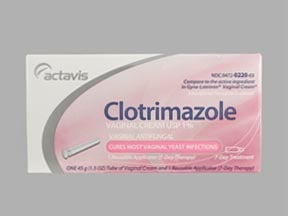
Ft Clotrimazole Coupons & Savings Card – Discount Prices from $7.99
Brand for: Clotrimazole
My prescription
Edit
45GM of 1%, Clotrimazole (1 Tube)
Select pharmacy

Walgreens
$7.99
COUPON PRICE
Albertsons
$8.10
COUPON PRICEFt Clotrimazole savings card
Show this card to your pharmacist
Walgreens
$7.99
BIN
ID
PCN
GRP
011867
LHCC658808
HT
LABH001
Powered by
More prescriptions for yeast infection
More prescriptions for yeast infection
Price history for Ft Clotrimazole (brand) & Clotrimazole (generic)
1 Tube, 45GM of 1%
Average retail price for Ft Clotrimazole
Average retail price for Clotrimazole
Average SaveHealth price for Clotrimazole
Our price history data is based on aggregated prescription data collected from participating pharmacies in America. Our prescription data updates daily to reflect the latest price changes. If you notice a missing data point, it means there wasn't sufficient data available to generate a monetary value for that date.
Over the last 12 months, the average discount price of Ft Clotrimazole is $4.32 using the SaveHealth savings card. That's an average savings of 32.71% on Ft Clotrimazole with our discount card.
*Retail prices are based on pharmacy claims data, and may not be accurate when we don't have enough claims.
Ft Clotrimazole dosage forms
| Dosage | Quantity | Price from | Per unit |
|---|---|---|---|
| 45GM of 1% | 1 Tube | $12.57 | $12.57 |
Ft Clotrimazole Warnings
When using clotrimazole, it's important to be aware of certain safety considerations to ensure effective and safe treatment:
Allergic Reactions: Individuals with a known hypersensitivity to clotrimazole or other imidazole antifungals should avoid using this medication. Signs of an allergic reaction may include rash, itching, swelling, dizziness, or difficulty breathing. If any of these symptoms occur, discontinue use and seek medical attention promptly.
Application Precautions: Clotrimazole is intended for external use only. Avoid contact with the eyes, mouth, or other mucous membranes. If accidental contact occurs, rinse thoroughly with water. Do not apply the medication to broken or irritated skin unless directed by a healthcare provider.
Use During Pregnancy and Breastfeeding: While topical clotrimazole is generally considered safe during pregnancy, especially in the second and third trimesters, it's advisable to consult a healthcare provider before use. The safety of clotrimazole during breastfeeding is not fully established; therefore, nursing mothers should seek medical advice prior to application.
Pediatric Use: The safety and efficacy of clotrimazole in children under 3 years of age have not been established. Therefore, it is not recommended for self-medication in this age group.
Vaginal Use Considerations: When using clotrimazole vaginal products, avoid concurrent use of tampons, douches, spermicides, or other vaginal products, as they may interfere with treatment effectiveness. Additionally, these products may weaken latex contraceptives like condoms and diaphragms, potentially reducing their effectiveness. It's advisable to abstain from sexual intercourse during treatment.
Monitoring and Duration of Use: If symptoms do not improve within the recommended treatment period—typically two weeks for jock itch and four weeks for athlete's foot or ringworm—discontinue use and consult a healthcare provider. Prolonged use without medical supervision may lead to complications or mask underlying conditions.
By adhering to these precautions, users can minimize potential risks associated with clotrimazole and ensure a safer treatment experience.
Ft Clotrimazole Side Effects
When using this medication, you may experience some mild side effects such as vaginal or urethral burning, itching, pain, or lower abdominal cramps. These effects are generally manageable and often do not persist. However, if they continue or worsen, it is important to seek advice from a healthcare professional. While serious side effects are uncommon, it is crucial to be aware of signs of a severe allergic reaction. Symptoms to watch for include a rash, intense itching or swelling, particularly of the face, tongue, or throat, severe dizziness, and difficulty breathing. If any of these occur, immediate medical attention is necessary. Remember, the majority of people using this medication do not encounter serious issues. If you experience any effects not mentioned here, it is advisable to reach out to a healthcare provider for further guidance.
Ft Clotrimazole Interactions
Clotrimazole, an antifungal medication, can interact with various drugs, potentially altering their effectiveness or increasing the risk of side effects. Notably, when used alongside Tacrolimus, an immunosuppressant commonly prescribed to transplant patients, clotrimazole can significantly raise tacrolimus blood levels. This increase may heighten the risk of tacrolimus-related side effects, such as kidney problems or infections. Therefore, patients on tacrolimus should have their blood levels closely monitored if they start or stop using clotrimazole, and dosage adjustments may be necessary.
Additionally, clotrimazole may interact with other medications metabolized by the liver enzyme CYP3A4. For instance, it can increase the blood levels of drugs like Midazolam, a sedative, by inhibiting this enzyme. This interaction could lead to enhanced sedative effects, including drowsiness or respiratory issues. Patients should inform their healthcare providers about all medications they are taking to assess potential interactions and adjust dosages accordingly.
It's also important to note that clotrimazole can affect the metabolism of certain other drugs, such as cisapride, leading to an increased risk of heart rhythm disturbances. Therefore, cisapride should not be co-administered with clotrimazole.
Given these potential interactions, it's crucial for patients to consult their healthcare providers before starting or stopping clotrimazole, especially if they are on medications metabolized by CYP3A4 or other liver enzymes. This ensures safe and effective use of all prescribed treatments.
Can you use clotrimazole on feet?
Yes, clotrimazole can be used on the feet. It is commonly used to treat fungal infections such as athlete's foot. It is important to follow the instructions on the packaging or those provided by a healthcare professional for proper application.
Is clotrimazole 1% good for toenail fungus?
Clotrimazole 1% is typically used for treating fungal infections on the skin, such as athlete's foot or ringworm. However, it is not the most effective treatment for toenail fungus. Toenail fungus often requires more potent antifungal medications, which may be in the form of oral medications or specially formulated topical treatments specifically designed for nails. It is advisable to consult a healthcare provider for appropriate treatment options for toenail fungus.
What is clotrimazole used to treat?
Clotrimazole is used to treat fungal infections. It is commonly applied to the skin to treat conditions such as athlete's foot, jock itch, and ringworm. It is also used to treat yeast infections, including those affecting the mouth and throat.
What types of infections can be treated with clotrimazole?
Clotrimazole is an antifungal medication used to treat various fungal infections. It is commonly used for treating infections such as athlete's foot, jock itch, ringworm, and yeast infections, including vaginal yeast infections and oral thrush.
Can you use clotrimazole cream on your toes?
Yes, clotrimazole cream can be used on the toes to treat fungal infections such as athlete's foot. It is important to follow the instructions on the packaging or those provided by a healthcare professional for proper application.
